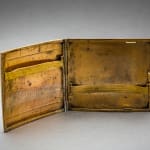Toledo workshop damascened cigarette case
8.9 x 7.6 cm
3 1/2 x 3 in
3 1/2 x 3 in
MS.1264
Gold inlaid rectangular cigarette case with the Palacio de Monterrey in Salamanca. The Monterrey palace is located in the centre of the city of Salamanca and it was constructed in...
Gold inlaid rectangular cigarette case with the Palacio de Monterrey in Salamanca.
The Monterrey palace is located in the centre of the city of Salamanca and it was constructed in the Italian Renaissance style for don Alonso de Zúñiga y Acevedo Fonseca, the 3rd count of Monterrey in 1539.
It has been declared a Historic National Monument of Spain since 1929. Damascening is the art of inlaying different metals into one another—typically, gold or silver are inlaid into a darkly oxidized steel background—to produce intricate patterns, much similar to the technique of niello. The English term derives from a perceived resemblance to the rich tapestry patterns of damask silk.
The technique of niello -a black mixture of copper, silver, and lead sulphides, used as an inlay on engraved or etched metal- has been attested in prehistoric Greece, with the earliest occurrence of damascening in the Aegean being a dagger from the Shaft Graves of Mycenae, dating to the latest Middle Bronze Age/Middle Helladic IIIB period (2000 BC. ca)
Cities that are known for a rich history in Damascening and in which the art is still practiced are Malaysia, Indonesia, Toledo in Spain, Eibar in the Basque Country and Kyoto in Japan.
The art of Damascening arrived to Toledo directly from Damascus and developed a very important industry around this craft, also known as Toledo Gold. The art of damascene has passed from generation to generation within the same family for centuries, and has become a hallmark of the city.
The Monterrey palace is located in the centre of the city of Salamanca and it was constructed in the Italian Renaissance style for don Alonso de Zúñiga y Acevedo Fonseca, the 3rd count of Monterrey in 1539.
It has been declared a Historic National Monument of Spain since 1929. Damascening is the art of inlaying different metals into one another—typically, gold or silver are inlaid into a darkly oxidized steel background—to produce intricate patterns, much similar to the technique of niello. The English term derives from a perceived resemblance to the rich tapestry patterns of damask silk.
The technique of niello -a black mixture of copper, silver, and lead sulphides, used as an inlay on engraved or etched metal- has been attested in prehistoric Greece, with the earliest occurrence of damascening in the Aegean being a dagger from the Shaft Graves of Mycenae, dating to the latest Middle Bronze Age/Middle Helladic IIIB period (2000 BC. ca)
Cities that are known for a rich history in Damascening and in which the art is still practiced are Malaysia, Indonesia, Toledo in Spain, Eibar in the Basque Country and Kyoto in Japan.
The art of Damascening arrived to Toledo directly from Damascus and developed a very important industry around this craft, also known as Toledo Gold. The art of damascene has passed from generation to generation within the same family for centuries, and has become a hallmark of the city.



